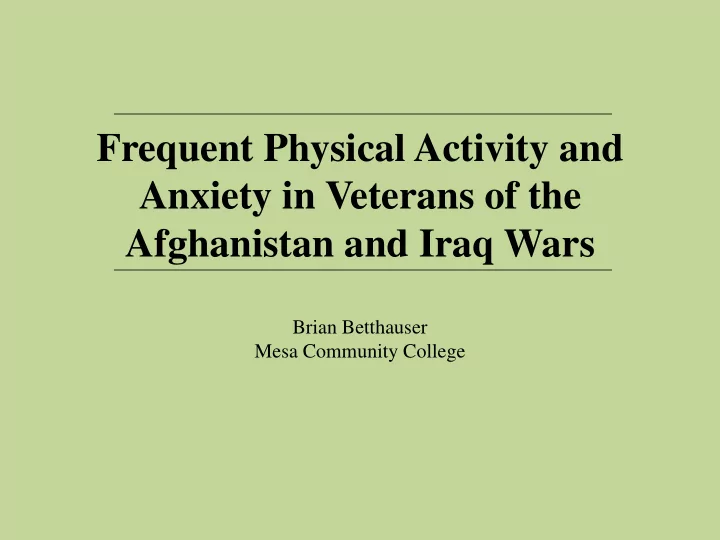

Frequent Physical Activity and Anxiety in Veterans of the Afghanistan and Iraq Wars Brian Betthauser Mesa Community College
Literature Review 1) “Physical activity in postdeployment OIF/OEF veteran using Dept. of Veterans Affairs services.” (Buis et al., 2011) - Decline in exercise among returning veterans: - 11.5% decrease in running - 3.6% decrease is exercising with gym equipment - 70% of 319 respondents stated exercise helps deal with stress 2) “Post-traumatic stress disorder is associated with poor health behaviors: Findings from the Heart and Soul Study.” (Zen et al., 2012) - PTSD linked to physical inactivity and other negative health factors - Physical inactivity more prevalent among sufferers of PTSD
Literature Review 3) “Invisible wounds: Mental health and cognitive care needs of America’s returning veterans.” (Rand Center for Military Health Policy Research, 2008) - Only 53% recently deployed veterans with PTSD sought care from a provider - 45% cite the possible side effects of drugs as a reason for not seeking treatment 4) “Iraq and afghanistan veterans: National findings from VA residential treatment programs” (Cook et al., 2013) - Limited time available to commit to residential and long-term treatment - Various forms of physical exercise used to regulate intense physical emotion
Literature Review 5) “A multidimensional wellness group therapy program for veterans with comorbid psychiatric and medical conditions” (Perlman et al., 2010) - Promoting healthy behaviors (exercise, sleep, etc.) significantly improved mental health 6) “Physical fitness influences stress reactions to extreme military training.” (Taylor et al., 2008) - Physical fitness acts as a buffer against future PTSD-inducing events - Performance on a physical fitness test inversely related to symptoms of PTSD 7) “Effects of sensory-enhanced yoga on symptoms of combat stress in deployed military personnel” (Stoller, Greuel, Cimini, Fowler, & Koomar, 2012) - Yoga helps manage combat stress and anxiety
Hypothesis OEF and OIF veterans who frequently engage in physical activity, defined by exercise lasting longer than 30 minutes at a time, on a weekly basis will experience less severe symptoms of anxiety, as measured with a survey using modified versions of the Modified PTSD Symptom Scale (MPSS-SR) and Beck Anxiety Inventory (BAI).
Participants 34 OEF and OEF veterans - Active Duty, Reserves, Separated or Retired - Average age = 26.5, age range = 21 – 43 - 32 males, 1 female, 1 unknown Average time overseas: 17.8 months Average number of deployments: 2.0 Average time in military service: 6.1 years
Materials and Procedure 3 Part Questionnaire 1) Demographics 2) Measure of anxiety symptoms (13 questions) - Frequency and severity - Modified PTSD Symptoms Scale (MPSS-SR) (Falsetti, Resnick, Resick, Kilpatrick, 1993) - Beck Anxiety Inventory (BAI) (Beck & Steer, 1993) 3) Average physical activity per week - Completed individually and returned electronically or by mail
Results r (32) = -.38, p = .03, r 2 = .14 - Significant negative correlation - Medium effect size Average weekly physical activity: M = 5.85 SD = 3.93 Anxiety score: M = 27.76 SD = 20.11
Results Average Times Exercised per Week vs. Anxiety Symptom Score
Results Means and Standard Deviations of Individual Symptom Measures Measures N M SD Bad dreams and Nightmares 34 1.97 2.02 Loss of interest 34 1.82 2.17 Difficulty sleeping 34 3.32 2.27 Fear of the worst happening 34 1.82 2.30 Irritability 34 2.85 2.13 Inability to relax 34 2.29 2.20 Difficulty concentrating 34 2.38 2.23 Nervousness 34 1.62 2.07 Overtly alert 34 2.88 2.14 Unsteadiness 34 1.71 1.73 Jumpy or easily startled 34 2.29 2.30 Scared or helpless 34 1.00 1.69 Intense physical reactions 34 1.79 2.21 Note . Means > 2.50 are in boldface. N = number of participants, M = mean, SD = standard deviation
Discussion Corresponds with the findings of Taylor et al. (2008) and Stoller et al. (2012) - Increased physical activity related to lower anxiety levels and less severe symptoms of PTSD Limitations: - Accessibility of participants and time - Nonresponse bias - Unknown reliability of survey measures Future Studies: - Experimental study examining the effects of varying intensities and types of exercise - Effects of exercise on specific symptoms of PTSD
References Beck, A.T., & Steer, R.A. (1993). Beck Anxiety Inventory Manual. San Antonio, TX: Psychological Corporation. Buis, L. R., Kotagal, L. V., Porcari, C. E., Rauch S.A., Krein, S. L., & Richardson, C. R. (2011). Physical activity in postdeployment Operation Iraqi Freedom/Operation Enduring Freedom veterans using Department of Veterans Affairs services. Journal Of Rehabilitation Research & Development , 48 (8), 901-911. doi:10.1682/JRRD.2010.08.0144 Cook, J., Dinnen, S., O’Donnell, C., Bernardy, N., Rosenheck, R., & Hoff, R. (2013). Iraq and afghanistan veterans: National findings from VA residential treatment programs. Psychiatry: Interpersonal & Biological Processes , 76 (1), 18-31. Falsetti, S. A., Resnick, H. S., Resick, P. A., & Kilpatrick, D. (1993). The Modified PTSD Symptom Scale: A brief self-report measure of posttraumatic stress disorder. The Behavioral Therapist, 16, 161-162. Perlman, L. M., Cohen, J. L., Altiere, M. J., Brennan, J. A., Brown, S. R., Mainka, J., & Diroff, C. R. (2010). A multidimensional wellness group therapy program for veterans with comorbid psychiatric and medical conditions. Professional Psychology: Research And Practice , 41 (2), 120- 127. doi:10.1037/a0018800 RAND Center for Military Health Policy Research. (2008). Invisible wounds: Mental health and cognitive care needs of America’s returning veterans. Retrieved March 3, 2014, from rand.org/pubs/monographs/MG720/ Stoller, C. C., Greuel, J. H., Cimini, L. S., Fowler, M. S., & Koomar, J. A. (2012). Effects of sensory-enhanced yoga on symptoms of combat stress in deployed military personnel. American Journal of Occupational Therapy, 66 , 59-68. doi: 10.5014/ajot.2012.001230 Taylor, M. K., Markham, A. E., Reis, J. P., Padilla, G. A., Potterat, E. G., Drummond, S. P. A., & Mujica-Parodi, L. R. (2008). Physical fitness influences stress reactions to extreme military training. Military Medicine , 173 (8), 738-742. Zen, A. L., Whooley, M. A., Zhao, S., & Cohen, B. E. (2012). Post-traumatic stress disorder is associated with poor health behaviors: Findings from the Heart and Soul Study. Health Psychology , 31 (2), 194-201. doi:10.1037/a0025989
Questions?
Recommend
More recommend